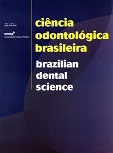Influência do tempo de armazenamento na resistência de união à microtração de diferentes sistemas adesivos em dentina superficial e profunda
DOI:
https://doi.org/10.14295/bds.2010.v13i1/2.8Abstract
O objetivo deste estudo foi avaliar a resistência de união (RU) de um sistema adesivo convencional (Adper™ Single Bond 2 [SB]) e de dois autocondicionantes (Adper™ SE Plus [SE] e AdheSE® [AD]) em dentina superficial (DS) e profunda (DP), nos tempos imediato (IM) e após 6 meses (6M) de armazenamento em água. Superfícies oclusais de 24 terceiros molares humanos foram seccionadas e smear layer padronizada. Após procedimentos adesivos, realizaram-se restaurações em resina composta sobre as superfícies dos dentes, que foram seccionados obtendo-se espécimes em forma de palitos (0,7 + 0,1 mm2). Os espécimes foram testados por meio do ensaio de microtração (0,5 mm/min), IM e após 6M de armazenamento em água. Os dados foram submetidos à ANOVA 3 fatores e pós-teste de Bonferroni (α=0,05). Na avaliação IM da RU, apenas o fator “adesivo” foi significativo (p<0,05). Os dados de RU após 6M mostraram que a interação dos fatores “adesivo e substrato dentinário” foi significativa (p<0,05). AD em DS (IM: 49,0 ± 6,7 MPa) mostrou diminuição significativa da RU após 6M (23,2 ± 7,9 MPa) de armazenamento em água. SE e AD mostraram diferença significativa (p<0,05) tanto em DS como em DP. Em DS o fator tempo foi significativo e em DP o fator adesivo. SB tanto em DS como em DP não apresentou diferença estatisticamente significante IM e após 6M (p>0,05). Conclui-se que diferentes níveis de profundidade dentinária podem afetar a RU para o mesmo material e que o fator tempo pode influenciar a degradação do sistema adesivo.
Downloads
Downloads
Published
How to Cite
Issue
Section
License
Brazilian Dental Science uses the Creative Commons (CC-BY 4.0) license, thus preserving the integrity of articles in an open access environment. The journal allows the author to retain publishing rights without restrictions.
=================




























